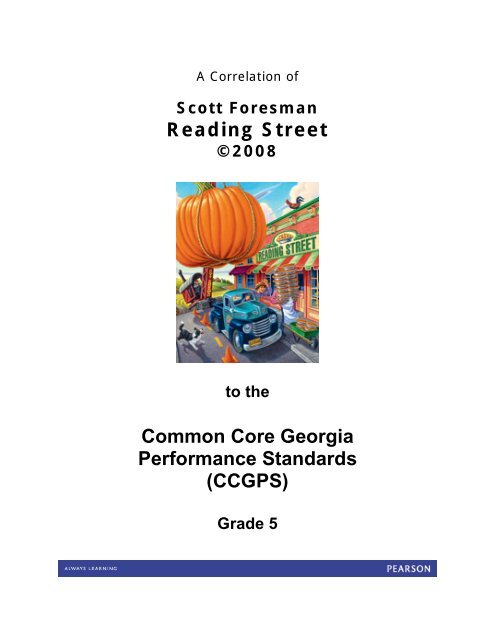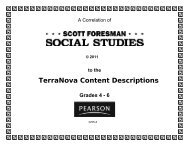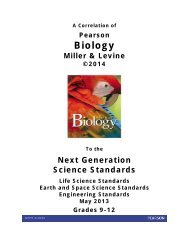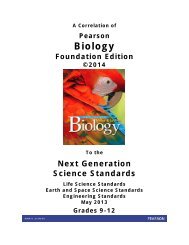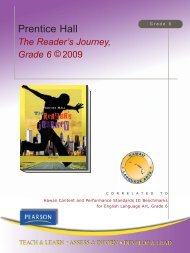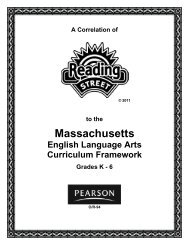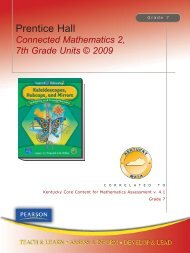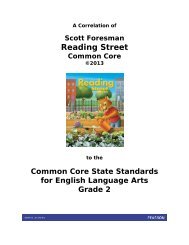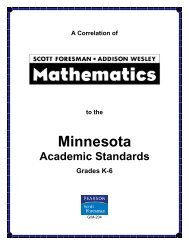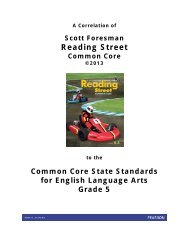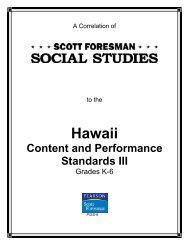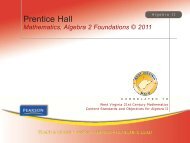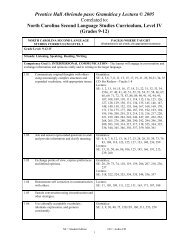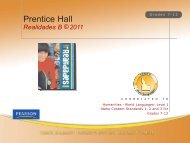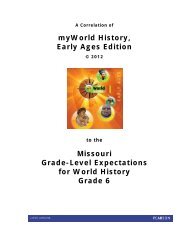Scott Foresman Reading Street - Pearson
Scott Foresman Reading Street - Pearson
Scott Foresman Reading Street - Pearson
Create successful ePaper yourself
Turn your PDF publications into a flip-book with our unique Google optimized e-Paper software.
<strong>Scott</strong> <strong>Foresman</strong> <strong>Reading</strong> <strong>Street</strong> © 2008to theCommon Core Georgia Performance Standards (CCGPS)Grade 5Table of ContentsFifth Grade <strong>Reading</strong> Literary (RL) .......................................................................... 4Fifth Grade <strong>Reading</strong> Informational (RI) ................................................................. 9Fifth Grade <strong>Reading</strong> Foundational (RF) ................................................................ 14Fifth Grade Writing (W) ....................................................................................... 18Fifth Grade Speaking and Listening (SL) .............................................................. 31Fifth Grade Language (L) ..................................................................................... 35SE = Student Edition3TE = Teacher’s Edition
<strong>Scott</strong> <strong>Foresman</strong> <strong>Reading</strong> <strong>Street</strong> © 2008to theCommon Core Georgia Performance Standards (CCGPS)Grade 5Common Core GeorgiaPerformance Standards – Grade 5Key Ideas and DetailsELACC5RL1: Quote accurately from a textwhen explaining what the text saysexplicitly and when drawing inferences fromthe text.Fifth Grade <strong>Reading</strong> Literary (RL)<strong>Scott</strong> <strong>Foresman</strong><strong>Reading</strong> <strong>Street</strong> © 2008SE: 248, 280, 408, 478TE 1: 28, 50; 2: 236, 243, 248; 3: 280;4: 408, 478The program provides Reader Responsequestions at the end of each StudentEdition selection and Strategy Self-Checkand Guiding Comprehension questions inthe Teacher’s Edition lessons for theselections. Students must cite textualevidence to support their answers to somequestions in these sections as well as tomake inferences and draw conclusions.(See, for example, TE 1: 28, 50.)ELACC5RL2: Determine a theme of astory, drama, or poem from details in thetext, including how characters in a story ordrama respond to challenges or how thespeaker in a poem reflects upon a topic;summarize the text.SE: 68–69, 75, 78, 81, 84, 236, 240, 470,582–583, 593, 596–597, 598, 601TE 1: 32, 62, 68–69, 74, 75, 78, 80, 81,82, 84, 89b, DI•26, DI•27; 2: 156, 202,236, 237, 240, 246; 3: 278; 4: 406, 470,476; 5: 528, 582–583, 592, 593, 596,597, 598, 601, DI•36, DI•37; 6: 648, 694,746As part of their analysis of each literarywork, students are asked to summarize, orretell, the text. To do this, they are taughtto recognize the most important ideas inthe text; to identify the main literaryelements, including characters, settings,plot, and theme; and to describe thesebriefly in their own words. Students alsorelate selections to unit themes of theprogram as well as identify the story’stheme. (See, for example, SE: 84 andTE 1: 68–69.)SE = Student Edition4TE = Teacher’s Edition
<strong>Scott</strong> <strong>Foresman</strong> <strong>Reading</strong> <strong>Street</strong> © 2008to theCommon Core Georgia Performance Standards (CCGPS)Grade 5Common Core GeorgiaPerformance Standards – Grade 5ELACC5RL3: Compare and contrast two ormore characters, settings, or events in astory or drama, drawing on specific detailsin the text (e.g., how characters interact).<strong>Scott</strong> <strong>Foresman</strong><strong>Reading</strong> <strong>Street</strong> © 2008SE: 142, 143, 149, 150, 153, 158, 186,187, 196, 199, 204, 385, 469, 476, 674,675, 680, 689, 693, 746TE 2: 142, 143, 148, 149, 150, 152, 158,161b, 186, 187, 196, 200, 204, 207b, 217,DI•26, DI•27, DI•52, DI•54; 3: 385; 4:468, 476; 6: 674, 675, 680, 681, 688, 689,692, 693, 699b, 746, DI•26, DI•27, DI•54Compare and Contrast and Character aremajor Comprehension Skills in the programand as such are well covered In both theStudent Edition and the Teacher’s Edition.Lessons in the Student Edition and theaccompanying Teacher’s Edition teachstudents how to identify, describe, andcompare and contrast the characters,settings, and events in the plots of storiesusing details from the texts. ReaderResponse questions in the Student Editionand questions in the Teacher’s Editioncheck students’ ability to compare andcontrast story elements.SE = Student Edition5TE = Teacher’s Edition
<strong>Scott</strong> <strong>Foresman</strong> <strong>Reading</strong> <strong>Street</strong> © 2008to theCommon Core Georgia Performance Standards (CCGPS)Grade 5Common Core GeorgiaPerformance Standards – Grade 5ELACC5RL9: Compare and contrast storiesin the same genre (e.g., mysteries andadventure stories) on their approaches tosimilar themes and topics.<strong>Scott</strong> <strong>Foresman</strong><strong>Reading</strong> <strong>Street</strong> © 2008SE: 89, 207, 253, 535TE 1: 89; 2: 207, 253; 5: 535; 6: 746As students are introduced to and readexamples of various story genres, theylearn about the characteristics thatdistinguish each genre from the others.Questions in the Student Edition andTeacher’s Edition ask students to comparethese stories and their elements to oneanother as well as to other stories theyhave read in the program. The programalso provides <strong>Reading</strong> Across Texts andWriting Across Texts that relate texts withsimilar themes and topics. See, forexample, SE: 41, 207. To expand students’experiences with stories from variouscultures, provide appropriate collections inthe classroom library or help students findsuitable materials in the school library andallow them time to read independently.Range of <strong>Reading</strong> and Level of Text ComplexityELACC5RL10: By the end of the year, read Each fiction selection has opportunities toand comprehend literature, including read a literary text independently,stories, dramas, and poetry, at the high proficiently, and fluently. See the followingend of the grades 4-5 text complexity band representative pages for the fictionindependently and proficiently.selections in Unit 1:SE: 22–33, 46–63, 72–83Fluency lessons focus on accuracy, rate,phrasing, punctuation cues, andexpression/intonation. Each sub skill isapplied to appropriate selections in avariety of reading activities. See, forexample, TE 1: 41a, 67a, 89a.Additionally, the Differentiated Instructionpages continue skill development asstudents read the ELL Reader and theBelow-Level, On-Level, and AdvancedLeveled Readers. Guided instruction andpractice are included on the DI and LRpages at the back of the unit. See TE 1:DI•2, DI•3, DI•10, DI•11, DI•12, DI•13,DI•20, DI•21, and LR1–LR18, for examplesof the Readers for the first two fictionselections in Unit 1.SE = Student Edition8TE = Teacher’s Edition
<strong>Scott</strong> <strong>Foresman</strong> <strong>Reading</strong> <strong>Street</strong> © 2008to theCommon Core Georgia Performance Standards (CCGPS)Grade 5Common Core GeorgiaPerformance Standards – Grade 5Key Ideas and DetailsELACC5RI1: Quote accurately from a textwhen explaining what the text saysexplicitly and when drawing inferences fromthe text.Fifth Grade <strong>Reading</strong> Informational (RI)<strong>Scott</strong> <strong>Foresman</strong><strong>Reading</strong> <strong>Street</strong> © 2008SE: 108, 310, 452, 498, 552, 668, 720TE 1: 108; 2: 172; 3: 310, 324, 330, 354;4: 452, 496, 498; 5: 544, 546, 552, 570;6: 668, 720Guiding Comprehension questions in theTeacher’s Edition and Reader Responsequestions in the Student Edition mayrequire students to support theirstatements and inferences with phrases orsentences quoted from the text. (See, forexample, Look Back and Write on TE 1:108.)ELACC5RI2: Determine two or more mainideas of a text and explain how they aresupported by key details; summarize thetext.SE: 112–113, 133, 288–289, 310, 313,315, 346–347, 358, 361, 363, 383, 624,654, 655, 660, 661, 668, 673TE 1: 112–113, 125, 126, 127, 133, DI•46,DI•47; 3: 288–289, 294, 295, 298, 299,300, 302, 303, 306, 307, 308, 309, 310,313, 315, 315b, 324, 325, 334, 335, 336,346–347, 352, 353, 354, 356, 358, 361,363, 363b, 383, DI•16, DI•17, DI•36,DI•37, DI•53, DI•55; 5: 544, 545, 550,618, 625, DI•48; 6: 654, 655, 666, 668,673, 673b, 710, 711, 716, 717, 718,DI•16, DI•17, DI•53The program provides explicit instruction inidentifying main idea and supporting detailsand summarizing text. Its Reader Responsequestions at the end of each StudentEdition selection and questions in theTeacher’s Edition may require students toidentify main ideas and details in texts or tosummarize the text.SE = Student Edition9TE = Teacher’s Edition
<strong>Scott</strong> <strong>Foresman</strong> <strong>Reading</strong> <strong>Street</strong> © 2008to theCommon Core Georgia Performance Standards (CCGPS)Grade 5Common Core GeorgiaPerformance Standards – Grade 5ELACC5RI3: Explain the relationships orinteractions between two or moreindividuals, events, ideas, or concepts in ahistorical, scientific, or technical text basedon specific information in the text.Craft and StructureELACC5RI4: Determine the meaning ofgeneral academic and domain-specificwords and phrases in a text relevant to agrade 5 topic or subject area.<strong>Scott</strong> <strong>Foresman</strong><strong>Reading</strong> <strong>Street</strong> © 2008SE: 111, 185, 345, 358, 363, 503, 576,673TE 1: 111; 2: 185; 3: 302, 345, 358, 363;4: 503; 5: 550, 576; 6: 662, 673, 708Questions in the Student Edition andTeacher’s Edition may direct students’attention to identifying the relationships ofevents or important concepts ininformational texts. Also, <strong>Reading</strong> AcrossTexts questions encourage students tocompare and contrast ideas in selectionswith similar topics, themes, or purposes butdifferent forms or points of view.SE: 92–93, 114–115, 144–145, 164–165,188–189, 210–211, 232–233, 290–291,318–319, 348–349, 366–367, 414–415,438–439, 486–487, 538–539, 562–563,606–607, 656–657, 702–703TE 1: 90l, 92b, 112l, 114b, LR28, LR30,LR31, LR33, LR34, LR36, LR37, LR39, LR40,LR42, LR43, LR45, DI•33–DI•35, DI•43–DI•45; 2: 162l, 164b, 208l, 210b, 230l,232b, LR10, LR12, LR13, LR15, LR16,LR18, LR28, LR30, LR31, LR33, LR34, LR36,LR37, LR39, LR40, LR42, LR43, LR45,DI•13–DI•15, DI•33–DI•35, DI•43–DI•45;3: 262l, 264b, 288l, 290b, 316l, 318b,346l, 348b, 364l, 366b, LR10, LR12, LR13,LR15, LR16, LR18, LR19, LR21, LR22, LR24,LR25, LR27, LR28, LR30, LR31, LR33, LR34,LR36, LR37, LR39, LR40, LR42, LR43, LR45,DI•13–DI•15, DI•23–DI•25, DI•33–DI•35,DI•43–DI•45; 4: 412l, 414b, 436l, 438b,484l, 486b, LR10, LR12, LR13, LR15, LR16,LR18, LR19, LR21, LR22, LR24, LR25, LR27,LR37, LR39, LR40, LR42, LR43, LR45,DI•13–DI•15, DI•23–DI•25, DI•43–DI•45;5: 536l, 538b, 560l, 562b, 604l, 606b,LR10, LR12, LR13, LR15, LR16, LR18, LR19,LR21, LR22, LR24, LR25, LR27, LR37, LR39,LR40, LR42, LR43, LR45, DI•13–DI•15,DI•23–DI•25, DI•43–DI•45; 6: 654l, 656b,700l, 702b, LR10, LR12, LR13, LR15, LR16,LR18, LR28, LR30, LR31, LR33, LR34, LR36,DI•13–DI•15, DI•33–DI•35SE = Student Edition10TE = Teacher’s Edition
<strong>Scott</strong> <strong>Foresman</strong> <strong>Reading</strong> <strong>Street</strong> © 2008to theCommon Core Georgia Performance Standards (CCGPS)Grade 5Common Core GeorgiaPerformance Standards – Grade 5(Continued)ELACC5RI4: Determine the meaning ofgeneral academic and domain-specificwords and phrases in a text relevant to agrade 5 topic or subject area.ELACC5RI5: Compare and contrast theoverall structure (e.g., chronology,comparison, cause/effect,problem/solution) of events, ideas,concepts, or information in two or moretexts.<strong>Scott</strong> <strong>Foresman</strong><strong>Reading</strong> <strong>Street</strong> © 2008(Continued)Each selection lesson plan contains ConceptVocabulary, which are content wordsrelated to the unit theme and the specificselection. Each selection also has LessonVocabulary, which are words related to theselection’s content. The Leveled Readersvocabulary pages reinforce the LessonVocabulary. See, for example, the followingrepresentative pages for the five-day lessonplan for the first nonfiction selection:TE 1: 90l, 92b, 92–93, 111cIn addition, content area vocabulary andconcepts for social studies and science arediscussed and presented in Time for…features and Content-Area Vocabulary. See,for example, TE 4: 435, 445, 447, 454,473, 480.SE: 111, 131, 133, 180, 185, 229, 253,315, 345, 383, 435, 457, 503, 559, 581,624, 671, 673, 725TE 1: 100, 101, 106, 111, 112–113, 119,120, 125, 126, 130, 131, 133, 133b,DI•46, DI•47, DI•56; 2: 176, 180, 182,185, 216, 217, 229, 246, 253; 3: 302, 315,345, 370, 372, 383; 4: 435, 446, 450, 457,503; 5: 542, 559, 570, 581, 612, 618, 625;6: 654–655, 662, 667, 671, 673, 708, 718,725, DI•16, DI•17Forms of text organization (method ofpresenting information) identified are causeand effect, compare and contrast, problemand solution, description, main idea anddetails, and sequence. The Student andTeacher’s Editions include selectionquestions that focus on text structure.SE = Student Edition11TE = Teacher’s Edition
<strong>Scott</strong> <strong>Foresman</strong> <strong>Reading</strong> <strong>Street</strong> © 2008to theCommon Core Georgia Performance Standards (CCGPS)Grade 5Common Core GeorgiaPerformance Standards – Grade 5ELACC5RI6: Analyze multiple accounts ofthe same event or topic, noting importantsimilarities and differences in the point ofview they represent.Integration of Knowledge and IdeasELACC5RI7: Draw on information frommultiple print or digital sources,demonstrating the ability to locate ananswer to a question quickly or to solve aproblem efficiently.ELACC5RI8: Explain how an author usesreasons and evidence to support particularpoints in a text, identifying which reasonsand evidence supports which point(s).<strong>Scott</strong> <strong>Foresman</strong><strong>Reading</strong> <strong>Street</strong> © 2008SE: 180, 345, 360, 363TE 2: 180, 184, 185b; 3: 345, 360, 363The purpose of the <strong>Reading</strong> Across Textsand Writing Across Texts questions andactivities in the Student Edition is to givestudents opportunities to compare multipletexts, a main selection and a secondaryselection, that have a related topic but aredifferent in other ways. Additional questionsin the Teacher’s Edition may also helpstudents compare information fromdifferent sources.SE: 130–133, 250–253, 380–383, 500–503, 578–581, 722–725TE 1: 41k, 41l, 67k, 67l, 89k, 89l, 111k,111l, 133k, 133l; 2: 161k, 161l, 185k,185l, 229k, 229l; 3: 315k, 315l, 363k,363l; 4: 435k, 435l, 457k, 457l, 483k,483l; 5: 535k, 535l, 559k, 559l, 581k,581l; 6: 725k, 725lUsing print and digital sources ofinformation is an important part of theTeacher’s Edition lessons. Sources includealmanacs, periodicals, dictionaries, onlinereference sources, Web sites, and more. Inaddition, specific Student Edition selectionsand their accompanying Teacher’s Editionlessons focus on digital sources and theirformats.SE: 212–223TE 2: 212–223, 229b; 5: 625bAs students read selections, they arereminded through questions in the StudentEdition and Teacher’s Edition to be aware ofthe author’s role in creating the selection.Relevant questions focus on the author’spurpose for writing, choice of topic orillustrations, inclusion or exclusion ofinformation, and use of evidence to supportan opinion, idea, or conclusion.SE = Student Edition12TE = Teacher’s Edition
<strong>Scott</strong> <strong>Foresman</strong> <strong>Reading</strong> <strong>Street</strong> © 2008to theCommon Core Georgia Performance Standards (CCGPS)Grade 5Common Core GeorgiaPerformance Standards – Grade 5ELACC5RI9: Integrate information fromseveral texts on the same topic in order towrite or speak about the subjectknowledgeably.<strong>Scott</strong> <strong>Foresman</strong><strong>Reading</strong> <strong>Street</strong> © 2008SE: 111, 133, 185, 229, 253, 315, 345,363, 383, 435, 457, 503, 581, 624, 673,725TE 1: 111, 133; 2: 185, 185d, 229, 253; 3:315, 345, 363, 363d, 383; 4: 435, 435d,457, 503, 503d; 5: 559d, 581, 581d, 625;6: 653h, 673, 673h, 725, 725h, 753hSpeaking activities, such as InformationalSpeech and Oral Presentation, and writingactivities and process lessons in WritingWorkshops, such as Research Report,require students to gather information. Inaddition, every lesson includes an InternetInquiry Activity on the New Literacies page,which guides students as they gatherinformation and synthesize it.Range of <strong>Reading</strong> and Level of Text ComplexityELACC5RI10: By the end of the year, read Each nonfiction selection has opportunitiesand comprehend informational texts, to read an informational text independently,including history/social studies, science, proficiently, and fluently. See the followingand technical texts, at the high end of the representative pages for informationalgrades 4-5 text complexity bandselections in Unit 1:independently and proficiently.SE: 94–107, 117–127Fluency lessons focus on accuracy, rate,phrasing, punctuation cues, andexpression/intonation. Each sub skill isapplied to appropriate selections with avariety of reading activities. See, forexample, TE 1: 111a, 133a.Additionally, the Differentiated Instructionpages continue skill development asstudents read the ELL Reader and theBelow-Level, On-Level, and AdvancedLeveled Readers. Guided instruction andpractice are included on the DI pages at theback of the unit. See TE 1: DI•40, DI•41,and LR28–LR36 for examples of theReaders for a nonfiction selection.SE = Student Edition13TE = Teacher’s Edition
<strong>Scott</strong> <strong>Foresman</strong> <strong>Reading</strong> <strong>Street</strong> © 2008to theCommon Core Georgia Performance Standards (CCGPS)Grade 5Common Core GeorgiaPerformance Standards – Grade 5Print ConceptsKindergarten and 1st grade onlyPhonological AwarenessKindergarten and 1st grade onlyPhonics and Word RecognitionELACC5RF3: Know and apply grade-levelphonics and word analysis skills in decodingwords.Fifth Grade <strong>Reading</strong> Foundational (RF)<strong>Scott</strong> <strong>Foresman</strong><strong>Reading</strong> <strong>Street</strong> © 2008SE: 20–21, 44–45, 92–93, 114–115, 144–145, 188–189, 210–211, 232–233, 264–265, 290–291, 318–319, 348–349, 366–367, 394–395, 414–415, 438–439, 460–461, 486–487, 514–515, 562–563, 584–585, 606–607, 656–657, 676–677, 702–703, 728–729TE 1: 20–21, 41c, 41i–41j, 44–45, 67c,67i–67j, 89c, 89i–89j, 92–93, 111c, 111i–111j, 114–115, 133c, 133i–133j; 2: 144–145, 161c, 161i–161j, 185c, 185i–185j,188–189, 207c, 207i–207j, 210–211, 229c,229i–229j, 232–233, 253c, 255i–255j; 3:264–265, 287c, 287i–287j, 290–291, 315c,315i–315j, 318–319, 345c, 345i–345j,348–349, 363c, 363i–363j, 366–367, 383c,383i–383j; 4: 394–395, 411c, 411i–411j,414–415, 435c, 435i–435j, 438–439, 457c,457i–457j, 460–461, 483c, 483i–483j,486–487, 503c, 503i–503j; 5: 514–515,535c, 535i–535j, 559c, 559i–559j, 562–563, 581c, 581i–581j, 584–585, 603c,603i–603j, 606–607, 625c, 625i–625j; 6:653i–653j, 656–657, 673c, 673i–673j,676–677, 699c, 699i–699j, 702–703, 725c,725i–725j, 728–729, 753c, 753i–753jThe program’s Vocabulary Strategy strandprovides a strategy for using wordstructure, including suffixes, prefixes, roots,compound words, and word origins, todecode words. The program’s Spellingstrand reinforces word analysis work byproviding encoding instruction with wordlists organized by patterns, word structure,and meaning. In addition, the program’sDifferentiated Instruction pages provideadditional work with phonics and wordanalysis skills. See, for example, TE 1:DI•1, DI•4, DI•5, DI•14, DI•15, DI•24,DI•34, DI•35, DI•44, DI•45.SE = Student Edition14TE = Teacher’s Edition
<strong>Scott</strong> <strong>Foresman</strong> <strong>Reading</strong> <strong>Street</strong> © 2008to theCommon Core Georgia Performance Standards (CCGPS)Grade 5Common Core GeorgiaPerformance Standards – Grade 5a. Use combined knowledge of all lettersoundcorrespondences, syllabicationpatterns, and morphology (e.g., roots andaffixes) to read accurately unfamiliar multisyllabicwords in context and out ofcontext.FluencyELACC5RF4: Read with sufficient accuracyand fluency to support comprehension.<strong>Scott</strong> <strong>Foresman</strong><strong>Reading</strong> <strong>Street</strong> © 2008The program’s Vocabulary Strategy strand(see references in Foundational Skills 3)provides a strategy for using wordstructure, including suffixes, prefixes, roots,compound words, and word origins, todecode words. The program’s Spelling andPhonics strand reinforces word analysiswork by providing encoding instruction withword lists organized by patterns, wordstructure, and meaning. In addition, theprogram’s Differentiated Instruction pagesprovide additional work with phonics andword analysis skills. See, for example, TE1: DI•1, DI•4, DI•5, DI•14, DI•15, DI•24,DI•25, DI•34, DI•35, DI•44, DI•45.Each week’s lesson provides opportunitiesfor students to practice reading aloud withfluency. Fluency activities focus onaccuracy, rate, phrasing, punctuation cues,and expression. The activities for accuracyencourage students to adjust rate tofacilitate comprehension and to read wordsaccurately. See the following examples:TE 1: 67a, DI•10, DI•20, DI•30, DI•40; 2:185a, DI•10, DI•20, DI•30, DI•40; 4:457a, DI•10, DI•20, DI•30, DI•40; 5:581a, DI•10, DI•20, DI•30, DI•40SE = Student Edition15TE = Teacher’s Edition
<strong>Scott</strong> <strong>Foresman</strong> <strong>Reading</strong> <strong>Street</strong> © 2008to theCommon Core Georgia Performance Standards (CCGPS)Grade 5Common Core GeorgiaPerformance Standards – Grade 5c. Use context to confirm or self-correctword recognition and understanding,rereading as necessary.<strong>Scott</strong> <strong>Foresman</strong><strong>Reading</strong> <strong>Street</strong> © 2008SE: 44–45, 92–93, 114–115, 210–211,264–265, 318–319, 348–349, 414–415,438–439, 460–461, 562–563, 584–585,702–703, 728–729TE 1: 24, 44–45, 52, 53, 67c, 92–93, 98,99, 111c, 114–115, 122, 123, 133b, DI•15,DI•35, DI•45; 2: 210–211, 218, 219, 229c,232b; 3: 264–265, 274, 275, 287c, 318–319, 330, 331, 345c, 348–349, 363c, 366b,DI•5, DI•25, DI•35; 4: 414–415, 424, 425,435c, 438–439, 446, 447, 457c, 460–461,472, 473, 483c, DI•15, DI•25, DI•35; 5:562–563, 570, 571, 581c, 584–585, 594,595, 603c, DI•25, DI•35; 6: 702–703, 708,709, 725c, 728–729, 736, 737, 740, 741,753c, DI•35, DI•45The program’s Vocabulary strand in theStudent and Teacher’s Editions providesinstruction in word-recognition strategiesand concepts including using context todetermine meaning of multiple-meaningand unfamiliar words. Questions in theTeacher’s Edition help students apply theskill as they read selections.SE = Student Edition17TE = Teacher’s Edition
<strong>Scott</strong> <strong>Foresman</strong> <strong>Reading</strong> <strong>Street</strong> © 2008to theCommon Core Georgia Performance Standards (CCGPS)Grade 5Common Core GeorgiaPerformance Standards – Grade 5Text Types and PurposesELACC5W1: Write opinion pieces on topicsor texts, supporting a point of view withreasons.Fifth Grade Writing (W)<strong>Scott</strong> <strong>Foresman</strong><strong>Reading</strong> <strong>Street</strong> © 2008SE: 179, 531, 599, 621TE 2: 179, 185g–185h; 5: 531, 535g–535h, 599, 603g–603h, 621, 625g–625h,WA2–WA9The program’s Write Now pages in theStudent Edition and the accompanyingTeacher’s Edition lessons guiding studentsthrough the writing process presentdifferent kinds of persuasive, or opinion,writing. As they work through the process,students use details to support theiropinions.a. Introduce a topic or text clearly, state anopinion, and create an organizationalstructure in which ideas are logicallygrouped to support the writer’s purpose.SE: 179, 531TE 2: 179, 185g–185h; 5: 531, 535g–535hThe Write Now pages in the Student Editionpresent persuasive and opinion writingopportunities. Students write advertisingbrochures, letters to the editor, persuasiveessays, and reviews. The writing sections inthe Teacher’s Edition identify features ofthe writing mode and guide students asthey write. Also, the Writing andAssessment pages guide students throughthe writing process, from writing prompt tofinished product. Students haveopportunities to write opinions in PersuasiveEssays.In addition, Look Back and Write promptsat the end of the selections in the StudentEdition often ask students to state theiropinion about an issue or topic in writing.(See, for example, SE: 224, 530, 720.)SE = Student Edition18TE = Teacher’s Edition
<strong>Scott</strong> <strong>Foresman</strong> <strong>Reading</strong> <strong>Street</strong> © 2008to theCommon Core Georgia Performance Standards (CCGPS)Grade 5Common Core GeorgiaPerformance Standards – Grade 5ELACC5W2: Write informative/explanatorytexts to examine a topic and convey ideasand information clearly.<strong>Scott</strong> <strong>Foresman</strong><strong>Reading</strong> <strong>Street</strong> © 2008SE: 64, 109, 205, 225, 338, 339, 358, 378,379, 408, 432, 478, 552, 576, 577, 598,620, 650, 651, 668, 696, 721, 748, 749TE 1: 64, 109, 111g–111h; 2: 161g–161h,205, 207g–207h, 225, 229g–229h, WA2–WA9; 3: 338, 339, 345g–345h, 358, 378,379, 383g–383h, WA2–WA9; 4: 408, 432,478; 5: 552, 576, 577, 581g–581h, 598,620; 6: 650, 651, 653g–653h, 668, 696,721, 725g–725h, 748, 749, 753g–753h,WA2–WA9The program’s Writing strand includesopportunities for writing a variety ofexpository texts, or informative/explanatorytexts. Together the Student Edition’s WriteNow pages and the weekly WritingWorkshops in the Teacher’s Edition guidestudents through the writing process inwhich they prewrite, draft, revise, edit, andpublish their written work. For example,students analyze a writing model and plan afirst draft in which they state the topic andorganize their ideas in a way that is logicalfor the kind of expository writing. Also, theWriting and Assessment (WA) pages guidestudents through a five-stage writingprocess, from expository writing prompt tofinished product. In addition, Look Back andWrite prompts at the end of the selectionsin the Student Edition often ask students towrite a main idea and supporting detailsabout a topic.SE = Student Edition20TE = Teacher’s Edition
<strong>Scott</strong> <strong>Foresman</strong> <strong>Reading</strong> <strong>Street</strong> © 2008to theCommon Core Georgia Performance Standards (CCGPS)Grade 5Common Core GeorgiaPerformance Standards – Grade 5a. Introduce a topic clearly, provide ageneral observation and focus, and grouprelated information logically; includeformatting (e.g., headings), illustrations,and multimedia when useful to aidingcomprehension.<strong>Scott</strong> <strong>Foresman</strong><strong>Reading</strong> <strong>Street</strong> © 2008SE: 178, 205, 225, 249, 339, 378, 498,552, 577, 651, 668, 669, 721, 749TE 1: 41k, 111g–111h, 133k; 2: 166g–166h, 178, 205, 207g–207h, 225, 229g–229h, 249, 253g–253h, WA3–WA4, WA6;3: 339, 345g–345h, 345k, 378, 383g–383h, WA2–WA9; 4: 411k, 457k, 498; 5:535k, 552, 559l, 577, 581g–581h, 603l,625l; 6: 651, 653g–653h, 653l, 668, 669,673g–673h, 673l, 699k, 721, 725g–725h, 725k, 725l, 749, 753k, WA2–WA9The Write Now pages in the Student Editionpresent several kinds of expository, orinformative/explanatory, writing, such asdirections, news article, and expositorycomposition. The Writing Workshops in theaccompanying Teacher’s Edition lessonsguide students step by step through thewriting process. For example, studentsanalyze a writing model and plan a firstdraft in which they state the topic andorganize their ideas in a way that is logicalfor the kind of expository writing.Also, the Writing and Assessment (WA)pages guide students through a five-stagewriting process, from expository writingprompt to finished product. In addition,Look Back and Write prompts at the end ofthe selections in the Student Edition oftenask students to write a main idea andsupporting details about a topic.SE = Student Edition21TE = Teacher’s Edition
<strong>Scott</strong> <strong>Foresman</strong> <strong>Reading</strong> <strong>Street</strong> © 2008to theCommon Core Georgia Performance Standards (CCGPS)Grade 5Common Core GeorgiaPerformance Standards – Grade 5b. Develop the topic with facts, definitions,concrete details, quotations, or otherinformation and examples related to thetopic.c. Link ideas within and across categories ofinformation using words, phrases, andclauses (e.g., in contrast, especially).<strong>Scott</strong> <strong>Foresman</strong><strong>Reading</strong> <strong>Street</strong> © 2008SE: 108, 225, 249, 338, 498, 668, 669,721, 749TE 1: 67k, 67l, 108, 111g–111h, 111l,133l; 2: 161k, 161l, 185k, 225, 229g–229h, 229k, 229l, 249, 253g–253h, 253k;3: 287k, 383k, 338, 345g–345h, 345k,WA4–WA5; 4: 411k, 411l, 457k, 457l, 498;5: 535k, 535l, 559l, 581g–581h, 581k,581l, 603k, 625l; 6: 653g–653h, 653k,668, 669, 673g–673h, 673k, 721, 725g–725h, 749, WA2–WA9The lessons provided in the Teacher’sEdition Writing Workshops help studentsfocus on the facts, details, and examplesthey use to develop their topic and study atopic pertinent to the writing form, such asKeeping a Focus or Organization.The WA pages, and Look Back and Writeprompts remind students that thedevelopment of the topic through facts,details, and examples is a key feature inexpository/informative/explanatory writing.TE 1: 89g–89h; 2: 159; 3: 311, 315h; 5:581h, 625h; 6: 749Students revise their drafts on Day 4 of theTeacher’s Edition lessons. Adding ordeleting information; reorganizingsentences or paragraphs; and addingtransition or linking words, phrases, orsentences are strategies that are suggestedto and discussed with students during therevising stage using the list of transitionwords and phrases on the back of the WAsection divider in the Teacher’s Edition.Also, as part of Peer Revision, students canpoint out places in their partners’ draftswhere linking words, phrases, or sentencescan be added to better join related ideasand information.SE = Student Edition22TE = Teacher’s Edition
<strong>Scott</strong> <strong>Foresman</strong> <strong>Reading</strong> <strong>Street</strong> © 2008to theCommon Core Georgia Performance Standards (CCGPS)Grade 5Common Core GeorgiaPerformance Standards – Grade 5d. Use precise language and domainspecificvocabulary to inform about orexplain the topic.e. Provide a concluding statement orsection related to the information orexplanation presented.<strong>Scott</strong> <strong>Foresman</strong><strong>Reading</strong> <strong>Street</strong> © 2008As students are introduced to differentforms of expository/informative /explanatory writing, they are alsointroduced to any vocabulary specific to agiven form and essential to creating anappropriate example of that form. Examplesinclude words for identifying similarities anddifferences for Compare and ContrastEssays and words for identifying time andorder for How-To Reports, and wordsrelated to letters such as greeting, body,and signature.SE: 85TE 1: 85, 89g–89h; 2: WA2–WA9; 3: WA2–WA9; 4: 603g–603hIn the program, students are introduced toand use content-related words in the formof every lesson’s concept vocabulary andlesson vocabulary. Students can use theseand other content-related words in theirown writing. See these representativeexamples from one lesson:SE: 70TE 1: 68l, 70–71Also, certain lessons focus on jargon.Students can use these and otherspecialized words in their own writing.TE 4: 449; 5: 543SE: 311, 379, 651TE 2: 161g–161h, WA2–WA9; 3: 311, 379,383g–383h, WA2–WA9; 5: 581g–581h; 6:651, 653g–653h, WA2–WA9The drafting and revising stages of writinglessons as well as models, and checklistseither provide examples of, support thewriting of, or remind students about theneed for a conclusion as part of thestructure of their expository/informative /explanatory writing. In addition, encouragestudents to practice writing sentences thatsummarize their ideas on their topic, whichthey could use to conclude their writing.SE = Student Edition23TE = Teacher’s Edition
<strong>Scott</strong> <strong>Foresman</strong> <strong>Reading</strong> <strong>Street</strong> © 2008to theCommon Core Georgia Performance Standards (CCGPS)Grade 5Common Core GeorgiaPerformance Standards – Grade 5ELACC5W3: Write narratives to developreal or imagined experiences or eventsusing effective technique, descriptivedetails, and clear event sequences.a. Orient the reader by establishing asituation and introducing a narrator and/orcharacters; organize an event sequencethat unfolds naturally.<strong>Scott</strong> <strong>Foresman</strong><strong>Reading</strong> <strong>Street</strong> © 2008SE: 35, 65, 85, 129, 205, 281, 339, 359,433, 453, 499, 697TE 1: 35, 41g–41h, 65, 67g–67h, 85, 89g–89h, 129, 133g–133h, WA2–WA9; 2: 205,207g–207h; 3: 281, 287g–287h, 339,345g–345h, 359, 363g–363h; 4: 433,435g–435h, 453, 457g–457h, 499, 503g–503h, WA2–WA9; 6: 697, 699g–699hThe program’s Writing strand includesopportunities for students to write thefollowing narrative forms: realistic fiction,personal narrative, poetry, tall tale, featurestory, journal, character sketch, animalstory, description, and skit. As studentswork through the writing process, they areguided to use effective techniques, clearsequence, and descriptive details indeveloping their stories.The Write Now pages in the Student Editionpresent writing genre and the daily Writingsections in the Teacher’s Edition WritingWorkshops guide students step by stepthrough the writing process. For example,students analyze a writing model and plan afirst draft in which they organize theirideas, taking into consideration theelements of the particular kind of narrativewriting. Also, the Writing and Assessment(WA) pages guide students through a fivestagewriting process, from narrativewriting prompt to finished product.SE: 65, 85, 281, 433TE 1: 65, 67g–67h, 85, 89g–89h, WA2–WA9; 3: 281, 287g–287h; 4: 433, 435g–435h, WA2–WA9See the statement for Writing Standard 3above. As students develop theirnarratives, they establish setting, introducecharacters, give their characters andnarrator a voice, and develop a plot, usinga logical sequence of events.SE = Student Edition24TE = Teacher’s Edition
<strong>Scott</strong> <strong>Foresman</strong> <strong>Reading</strong> <strong>Street</strong> © 2008to theCommon Core Georgia Performance Standards (CCGPS)Grade 5Common Core GeorgiaPerformance Standards – Grade 5b. Use narrative techniques, such asdialogue, description, and pacing, todevelop experiences and events or showthe responses of characters to situations.c. Use a variety of transitional words,phrases, and clauses to manage thesequence of events.<strong>Scott</strong> <strong>Foresman</strong><strong>Reading</strong> <strong>Street</strong> © 2008SE: 85, 281, 359, 433, 499TE 1: 85, 89g–89h, WA2–WA9; 2: WA2–WA9; 3: 287, 287g–287h, 359, 363g–363h; 4: 433, 435g–435h, 499, 503g–503hThe Write Now pages in the Student Editionpresent a variety of narrative writing forms,including personal narrative, charactersketch, animal story, tall tale, and skit. Thedaily Writing sections in the accompanyingTeacher’s Edition lessons guide studentsstep by step through the writing process.For example, on Days 1 and 2, studentsanalyze a writing model and plan a firstdraft in which they organize their ideas,taking into consideration the elements ofthe particular kind of narrative writing.Also, the Writing and Assessment (WA)pages guide students through a five-stagewriting process, from narrative writingprompt to finished product.TE 1: 85, 85g–85h; 2: WA2–WA9;3: 345g; 4: WA2–WA9The use of time-related clue words are firstdiscussed in lessons related to writing afriendly letter. Students can applytransitional words, phrases, and clauses totheir narrative writing as well.The program’s Comprehension strandlessons focus on sequence and clue wordsand phrases that show sequence. Studentscan apply their understandings to their ownwriting. (See, for example, TE 1: 90–91,97, 121). In addition, as students revisetheir writing for clarity, encourage them touse time-related clue words and othertransitional words in their writing. Remindstudents that time order words and phrasesinclude first, next, then, last, finally, after,before, later, in the meantime, and phrasesthat mention times of day, days, months,or years.SE = Student Edition25TE = Teacher’s Edition
<strong>Scott</strong> <strong>Foresman</strong> <strong>Reading</strong> <strong>Street</strong> © 2008to theCommon Core Georgia Performance Standards (CCGPS)Grade 5Common Core GeorgiaPerformance Standards – Grade 5d. Use concrete words and phrases andsensory details to convey experiences andevents precisely.e. Provide a conclusion that follows fromthe narrated experiences or events.<strong>Scott</strong> <strong>Foresman</strong><strong>Reading</strong> <strong>Street</strong> © 2008SE: 359, 453, 499, 553TE 1: 65, 111g, 129, 133h; 2: 229g–229h,WA5; 3: 281g, 359, 363g–363h; 4: 453,503g–503h, WA4; 5: 553Both the Student Edition and Teacher’sEdition lessons emphasize the importanceof word choice in writing. In addition todiscussing specific examples of concreteand sensory words and phrases in modelsin the Student Edition and the Teacher’sEdition, a lesson may focus on word choice.In addition, Literary Terms lessons focusingon word choice and sensory words anddetails help students identify effective wordusage, which they can then apply to theirown writing. (See TE 1: 79; 5: 543.)SE: 205, 339, 359, 433, 453, 499TE 1: WA2; 2: 205, 207g–207h, WA5;3: 339, 345g–345h, 359; 4: 433, 453,457g–457h, 499, WA5The drafting and revising stages of writinglessons as well as models, graphicorganizers, and checklists either provideexamples of, support the writing of, orremind students about the need for aconclusion as an important part of thestructure of their narrative writing. Inaddition, ask students to reread theconclusions of several favorite stories orbooks and note how these authors wrap uptheir narratives in satisfying ways. Suggestthat students then evaluate how well theirconclusion performs the same task.SE = Student Edition26TE = Teacher’s Edition
<strong>Scott</strong> <strong>Foresman</strong> <strong>Reading</strong> <strong>Street</strong> © 2008to theCommon Core Georgia Performance Standards (CCGPS)Grade 5Common Core GeorgiaPerformance Standards – Grade 5Production and Distribution of WritingELACC5W4: Produce clear and coherentwriting in which the development andorganization are appropriate to task,purpose, and audience. (Grade-specificexpectations for writing types are defined inStandards 1–3 above.)ELACC5W5: With guidance and supportfrom peers and adults, develop andstrengthen writing as needed by planning,revising, and editing. (Editing forconventions should demonstrate commandof Language Standards 1–3 up to andincluding grade 5.)<strong>Scott</strong> <strong>Foresman</strong><strong>Reading</strong> <strong>Street</strong> © 2008Every week, students are introduced to anew writing form in the Student Edition.The Teacher’s Edition Writing Workshopsguide students through the process ofwriting for that particular form or in writingthe form in tests. The unit Writing andAssessment pages also use a step-by-stepwriting process to present another type ofwriting. Students are given manyopportunities to produce examples of clear,coherent writing in which they demonstratetheir understanding of the requirements fora particular writing task, purpose, andaudience. See the following representativepages:TE 1: 65, 67g–67h; 3: 281, 287g–287h;4: 503g–503hTE 1: 41g–41h, 67g–67h, 89g–89h, 111g–111h, 133g–133h, WA1–WA6; 2: 161g–161h, 185g–185h, 207g–207h, 229g–229h,253g–253h, WA1–WA6; 3: 287g–287h,315g–315h, 345g–345h, 363g–363h,383g–383h, WA1–WA6; 4: 411g–411h,435g–435h, 457f–457g, 483g–483h, 503g–503h, WA1–WA6; 5: 535g–535h, 559g–559h, 581g–581h, 603g–603h, 625g–625h,WA1–WA6; 6: 653g–653h, 673g–673h,699g–699h, 725g–725h, 753g–753h, WA1–WA6Many weekly Writing Workshops and theunit Writing and Assessment lessons in theTeacher’s Edition are based on an approachthat divides the writing process into steps.Four of these steps are Prewrite, Draft,Revise, and Edit. The Revise step caninclude Peer Revision, during which studentpartners exchange drafts and offer ideas forstrengthening one another’s writing.SE = Student Edition27TE = Teacher’s Edition
<strong>Scott</strong> <strong>Foresman</strong> <strong>Reading</strong> <strong>Street</strong> © 2008to theCommon Core Georgia Performance Standards (CCGPS)Grade 5Common Core GeorgiaPerformance Standards – Grade 5ELACC5W6: With some guidance andsupport from adults, use technology,including the Internet, to produce andpublish writing as well as to interact andcollaborate with others; demonstratesufficient command of keyboarding skills totype a minimum of two pages in a singlesitting.<strong>Scott</strong> <strong>Foresman</strong><strong>Reading</strong> <strong>Street</strong> © 2008TE 1: WA6, WA9; 2: WA6, WA9; 3: 287k,315k, 363k, 383k, WA6, WA9; 4: 411k,435k, 503k, WA6, WA9; 5: 535k, 559k,581k, 603k, 625k, WA6, WA9; 6: 673k,725k, 753k, WA6, WA9These pages focus on the use of thecomputer to enhance writing skillacquisition with the object of productionand publication of writing. They also focuson skill application to meet curriculumexpectations.Research to Build and Present KnowledgeELACC5W7: Conduct short research TE 1: 41k, 67k, 89k, 111k, 133k; 2: 161k,projects that use several sources to build 185k, 207k, 229k, 253k; 3: 287k, 315k,knowledge through investigation of345k, 363k, 383k; 4: 411k, 435k, 457k,different aspects of a topic.483k, 503k; 5: 535k, 559k, 581k, 603k,625k; 6: 653k, 673k, 699k, 725k, 753kEach Teacher’s Edition lesson contains aweekly research project. The topic of thisresearch project is always tied to theQuestion of the Week and the topic of themain Student Edition selection. Theresearch project is divided into five steps—Identify Questions, Navigate/Search,Analyze, Synthesize, and Communicate—and one step is presented on each of thefive days in the lesson. Students begin byposing questions about the topic and endby presenting a brief report on the topic totheir classmates.ELACC5W8: Recall relevant informationfrom experiences or gather relevantinformation from print and digital sources;summarize or paraphrase information innotes and finished work, and provide a listof sources.TE 1: 41k, 67k, 89k, 111k, 133k; 2: 161k,185k, 207k, 229k, 253k; 3: 287k, 315k,345k, 363k, 383k; 4: 411k, 435k, 457k,483k, 503k; 5: 535k, 559k, 581k, 603k,625k; 6: 653k, 673k, 699k, 725k, 753kThe weekly research project in the NewLiteracies section of the Teacher’s Edition isdivided into five steps. During theNavigate/Search step, students gatherrelevant information from various sources,take notes, and organize their evidence.During Analyze and Synthesize, theyrestate the information they find. DuringSynthesize, they also collect and arrangeinformation from the sources they used.SE = Student Edition28TE = Teacher’s Edition
<strong>Scott</strong> <strong>Foresman</strong> <strong>Reading</strong> <strong>Street</strong> © 2008to theCommon Core Georgia Performance Standards (CCGPS)Grade 5Common Core GeorgiaPerformance Standards – Grade 5ELACC5W9: Draw evidence from literary orinformational texts to support analysis,reflection, and research.a. Apply grade 5 <strong>Reading</strong> Standards toliterature (e.g., “Compare and contrast twoor more characters, settings, or events in astory or a drama, drawing on specificdetails in the text [e.g., how charactersinteract+”).<strong>Scott</strong> <strong>Foresman</strong><strong>Reading</strong> <strong>Street</strong> © 2008SE: 84, 108, 128, 158, 178, 204, 224, 248,338, 358, 432, 478, 498, 530, 576, 620,650, 668, 696, 720TE 1: 84, 108, 128; 2: 158, 178, 204, 224,248; 3: 338, 358; 4: 432, 478, 498; 5:530, 576, 620; 6: 650, 668, 696, 720The Look Back and Write prompts at theend of the informational texts in theStudent Edition ask students to writeextended responses to questions about thetexts.SE: 34, 64, 84, 158, 204, 248, 280, 408,478, 530, 598, 650, 696, 748TE 1: 34, 64, 84; 2: 158, 204, 248; 3:280; 4: 408, 478; 5: 530, 598; 6: 650,696, 748The Look Back and Write prompts (question5) at the end of the literature texts in theStudent Edition ask students to writeextended responses to questions about thetexts. These questions require students toanalyze and reflect on the literature, toprovide evidence from the texts to supporttheir ideas, and to demonstrate what theyhave learned about the key features ofliterature texts. The accompanyingTeacher’s Edition pages provide guidelinesand scoring rubrics for evaluating students’responses.SE = Student Edition29TE = Teacher’s Edition
<strong>Scott</strong> <strong>Foresman</strong> <strong>Reading</strong> <strong>Street</strong> © 2008to theCommon Core Georgia Performance Standards (CCGPS)Grade 5Common Core GeorgiaPerformance Standards – Grade 5b. Apply grade 5 <strong>Reading</strong> Standards toinformational texts (e.g., Explain how anauthor uses reasons and evidence tosupport particular points in a text,identifying which reasons and evidencesupports which point[s]).Range of WritingELACC5W10: Write routinely overextended time frames (time for research,reflection, and revision) and shorter timeframes (a single sitting or a day or two) fora range of discipline-specific tasks,purposes, and audiences.<strong>Scott</strong> <strong>Foresman</strong><strong>Reading</strong> <strong>Street</strong> © 2008SE: 108, 128, 178, 224, 310, 338, 358,378, 432, 452, 498, 552, 576, 620, 668,720TE 1: 108, 128; 2: 178, 224; 3: 310, 338,358, 378; 4: 432, 452, 498; 5: 552, 576,620; 6: 668, 720The Look Back and Write (question 5)prompts at the end of the informationaltexts in the Student Edition ask students towrite extended responses to questionsabout the texts. These questions requirestudents to analyze and reflect on thetexts, to provide evidence from the texts tosupport their ideas, and to demonstratewhat they have learned about the keyfeatures of informational texts. Theaccompanying Teacher’s Edition pagesprovide guidelines and scoring rubrics forevaluating students’ responses.SE: 34, 64, 84, 108, 128, 158, 178, 204,224, 248, 280, 310, 338, 358, 378, 408,432, 452, 478, 498, 530, 552, 576, 598,620, 650, 668, 696, 720, 748TE 1: 34, 64, 84, 108, 128; 2: 158, 178,204, 224, 248; 3: 280, 310, 338, 358, 378;4: 408, 432, 452, 478, 498; 5: 530, 552,576, 598, 620; 6: 650, 668, 696, 720, 748For a week’s Writing strand, studentscomplete a writing project, which, becauseit takes place over the course of five days,gives them time for research, reflection,and revision. Throughout the week,students also complete numerous shorterwriting tasks. In addition, Writing andAssessment activities for the unit guidestudents through the five-step writingprocess. See the WA pages in any Teacher’sEdition for examples.SE = Student Edition30TE = Teacher’s Edition
<strong>Scott</strong> <strong>Foresman</strong> <strong>Reading</strong> <strong>Street</strong> © 2008to theCommon Core Georgia Performance Standards (CCGPS)Grade 5Common Core GeorgiaPerformance Standards – Grade 5Comprehension and CollaborationELACC5SL1: Engage effectively in a rangeof collaborative discussions (one-on-one, ingroups, and teacher-led) with diversepartners on grade 5 topics and texts,building on others’ ideas and expressingtheir own clearly.Fifth Grade Speaking and Listening (SL)<strong>Scott</strong> <strong>Foresman</strong><strong>Reading</strong> <strong>Street</strong> © 2008Each selection lesson plan contains multipleopportunities for students to initiate andengage in group discussions of grade 5topics and texts. See the followingrepresentative pages:SE: 34, 64, 84, 108, 128TE 1: 20a, 20, 22–23, 30, 34, 44a, 44, 46–47, 56, 64, 70a, 70, 72–73, 80, 84, 92a,92, 94–95, 104, 108, 114a, 114, 116–117,124, 128a. Come to discussions prepared, havingread or studied required material; explicitlydraw on that preparation and otherinformation known about the topic toexplore ideas under discussion.b. Follow agreed-upon rules for discussionsand carry out assigned roles.c. Pose and respond to specific questions bymaking comments that contribute to thediscussion and elaborate on the remarks ofothers.Retelling opportunities are provided witheach selection. In these activities, studentsdescribe main ideas and important ideasand draw conclusions from the text. Inaddition, the Speaking and Listeningactivities in the Teacher’s Edition lessonsoffer opportunities for students toparticipate in speaking activities that buildon the reading selections. See the followingrepresentative pages:SE: 34, 64, 84, 108, 128TE 1: 34–35, 41d, 64–65, 67d, 84–85,89d, 108–109, 111d, 128–129, 133dThe Speaking and Listening activities in theTeacher’s Edition lessons identify rules forgood listening, speaking, and teamwork.See, for example, TE 2: 229d; 5: 625d.TE 1: 89d, 133d; 5: 559dSpeaking and Listening activities in theTeacher’s Edition lessons provide tipsadvising students to ask questions to clarifyunderstandings of information presentedorally. The program also teaches thequestioning strategy to help students derivemeaning as they read. (See, for example,SE: 90–91 andTE 1: 90–91, 103, 105, 107.)SE = Student Edition31TE = Teacher’s Edition
<strong>Scott</strong> <strong>Foresman</strong> <strong>Reading</strong> <strong>Street</strong> © 2008to theCommon Core Georgia Performance Standards (CCGPS)Grade 5Common Core GeorgiaPerformance Standards – Grade 5d. Review the key ideas expressed anddraw conclusions in light of information andknowledge gained from the discussions.ELACC5SL2: Summarize a written textread aloud or information presented indiverse media and formats, includingvisually, quantitatively, and orally.<strong>Scott</strong> <strong>Foresman</strong><strong>Reading</strong> <strong>Street</strong> © 2008Speaking and Listening activities in theTeacher’s Edition lessons provide tipsencouraging students to use pertinentcomments that help clarify and extend theirunderstandings, improve their ownpresentations, and provide suggestions thatbuild on the ideas of others. The Synthesizeand Communicate phases of the NewLiteracies strand as well as the Conceptdiscussions provide additional opportunitiesfor students to incorporate others’ ideas toreinforce and extend their ownunderstandings. See the followingrepresentative pages:SE: 108, 310, 598TE 1: 94–95, 108, 111d, 111k; 3: 292–293, 310, 315d, 315k; 5: 586–587, 598,603d, 603kThe program teaches summarizing skills inwhich students are guided in summarizingand retelling important ideas in writtenmaterials. See, for example, SE: 112 andTE 1: 112–113, 125, 127, 133. Studentscan apply this skill to summarizinggraphically, visually, quantitatively, andorally presented material because studentsare required to analyze and restateinformation. Also, the Communicate phaseof the weekly New Literacies projectencourages students to understandillustrations and other graphics used inpresentations. See the following examples:TE 1: 111k; 2: 207k, 229k, 253k; 3: 287k,383kSE = Student Edition32TE = Teacher’s Edition
<strong>Scott</strong> <strong>Foresman</strong> <strong>Reading</strong> <strong>Street</strong> © 2008to theCommon Core Georgia Performance Standards (CCGPS)Grade 5Common Core GeorgiaPerformance Standards – Grade 5ELACC5SL3: Summarize the points aspeaker makes and explain how each claimis supported by reasons and evidence.Presentation of Knowledge and IdeasELACC5SL4: Report on a topic or text orpresent an opinion, sequencing ideaslogically and using appropriate facts andrelevant, descriptive details to support mainideas or themes; speak clearly at anunderstandable pace.<strong>Scott</strong> <strong>Foresman</strong><strong>Reading</strong> <strong>Street</strong> © 2008TE 2: 161d, 229d; 5: 625dThe program selections include persuasiveessays and persuasive texts. Teacher’sEdition Genre pages help students identifypersuasive techniques and supportingevidence. See, for example, TE 5: 625b.These provide background that enablesstudents to identify claims and supportingevidence in speeches and debates. A simpledebate opportunity is provided on pages TE2: 229d; 5: 625b. This is an opportunity toanalyze claims and supporting evidence. Inaddition, the Writing strand in the programidentifies the key features of persuasiveand opinion writing. See, for example, thepersuasive essay writing in TE 5: 535g–535h, 603g–603h, 625g–625h and thepersuasive writing activity in Writing andAssessment TE 5: WA2–WA9. Providestudents the opportunity to orally presenttheir essays to the class. For eachpresentation, classmates should identify thepurpose of the essay, the facts used asevidence to support the proposition, andthe impact the essay had on them.TE 2: 185d; 3: 363d, 383d; 4: 435d, 503d;5: 559d, 581dThe Speaking and Listening activities in theTeacher’s Edition provide numerousopportunities for students to preparepresentations with appropriate main ideasand supporting details. Students gatherinformation, write the presentation, preparevisuals, and finally give the presentation.Use the Main Idea and Details lessons inthe Comprehension strand to reinforceunderstanding of the concepts.The strand provides instruction inidentifying main ideas and details in writtenmaterials. See, for example, TE 3: 288–289, 295, 299, 307. Review identifyingmain idea and details to help students asthey prepare their presentations. Remindthem to include supportive facts and detailsfor their main ideas in their presentations.SE = Student Edition33TE = Teacher’s Edition
<strong>Scott</strong> <strong>Foresman</strong> <strong>Reading</strong> <strong>Street</strong> © 2008to theCommon Core Georgia Performance Standards (CCGPS)Grade 5Common Core GeorgiaPerformance Standards – Grade 5ELACC5SL5: Include multimediacomponents (e.g., graphics, sound) andvisual displays in presentations whenappropriate to enhance the development ofmain ideas or themes.ELACC5SL6: Adapt speech to a variety ofcontexts and tasks, using formal Englishwhen appropriate to task and situation.(See grade 5 Language Standards 1 and 3for specific expectations.)<strong>Scott</strong> <strong>Foresman</strong><strong>Reading</strong> <strong>Street</strong> © 2008TE 2: 185d; 3: 383d; 4: 503d; 5: 559d,581dThe Speaking and Listening activities of theTeacher’s Edition lessons suggest usingvisuals to support oral presentations.Suggestions for the types of visuals to useand where to find appropriate visuals areincluded. In addition, many of the weeklyNew Literacies projects include preparingand presenting visual materials. See, forexample, TE 2: 205k, 253k.TE 1: 111d; 2: 161d, 229d, 253d; 4: 411d,503d; 5: 581d, 625dStudents have many opportunities todetermine which kind of language to use inpresentations and discussions in theSpeaking and Listening lessons in theTeacher’s Edition pages and as part of theweekly Research and Inquiry project in theTeacher’s Edition.Help students decide whether to use formalor informal language based on the type ofspeaking situation before they beginpreparing for their presentations ordiscussions. As an additional aid, identifysituations and ask students whether thecontext requires formal language and toexplain why. Use these contexts: aconversation with family members, a jobinterview, a political campaign speech, anawards ceremony, instructions for how toplay a game, and so on. Then whenstudents begin working on each speakingactivity in the program, have them identifythe reason for speaking and whether theyshould use formal or informal language fortheir presentation.SE = Student Edition34TE = Teacher’s Edition
<strong>Scott</strong> <strong>Foresman</strong> <strong>Reading</strong> <strong>Street</strong> © 2008to theCommon Core Georgia Performance Standards (CCGPS)Grade 5Common Core GeorgiaPerformance Standards – Grade 5Conventions of Standard EnglishELACC5L1: Demonstrate command of theconventions of Standard English grammarand usage when writing or speaking.Fifth Grade Language (L)<strong>Scott</strong> <strong>Foresman</strong><strong>Reading</strong> <strong>Street</strong> © 2008Grammar and usage, along withcapitalization and punctuation, are taughtin conjunction with weekly Grammar andWriting lessons. For other writingassignment pages, students are remindedto edit their writing for proper grammar andconventions usage with checklists. TheWriting and Assessment pages itemizewriting traits including those forconventions such as grammar, usage,spelling, punctuation, capitalization, andparagraphing and contain rubrics fornarrative, descriptive, persuasive, andexpository writing modes. The Speakingand other presentation activity sectionsemphasize using correct grammar,sentence forms, and word choice. See thefollowing representative pages from Unit 1:TE 1: 18k, 18, 21, 35, 41, 41b, 41d, 41e–41f, 41g–41h, 41k, 41l, 42j, 42, 45, 65, 67,67b, 67d, 67e–67f, 67g–67h, 67k, 67l, 68k,68, 71, 85, 89, 89b, 89d, 89e–89f, 89g–89h, 89k, 89l, 90k, 90, 93, 109, 111, 111b,111d, 111e–111f, 111g–111h, 111k, 111l,112k, 112, 115, 129, 133, 133b, 133d,133e–133f, 133g–133h, 133k, 139, WA1–WA9, WA11–WA14a. Explain the function of conjunctions,prepositions, and interjections in generaland their function in particular sentences.TE 1: 41e–41f, 89f, 111f; 3: 383e–383f;6: 673e–673fThe program includes work withprepositions (and prepositional phrases)and lessons focus on both coordinating(and, but, or) and subordinating (because,after, before) conjunctions.SE = Student Edition35TE = Teacher’s Edition
<strong>Scott</strong> <strong>Foresman</strong> <strong>Reading</strong> <strong>Street</strong> © 2008to theCommon Core Georgia Performance Standards (CCGPS)Grade 5Common Core GeorgiaPerformance Standards – Grade 5b. Form and use the perfect (e.g., I hadwalked; I have walked; I will have walked)verb aspects.<strong>Scott</strong> <strong>Foresman</strong><strong>Reading</strong> <strong>Street</strong> © 2008In the Grammar strand, lessons areprovided for identifying simple tenses, mainverbs, and helping verbs, irregular verbs,and the principal parts of verbs. In the firstlesson on the principal parts of regularverbs (TE 3: 315e–315f), the perfecttenses are discussed on Day 4.You may also want to discuss verb aspects,which describe the nature of the action ofthe verb. The simple or indefinite aspectdescribes the action but does not determineif the action is finished. The complete orperfect aspect describes the completedaction, while the continuing or progressiveaspect describes an unfinished event oraction that is still going on in the present,past, or future.As you discuss the perfect tenses withstudents, note that they reflect the perfectaspect of a verb. Remind them that thepresent perfect identifies action that tookplace at an indefinite time in the past andhas been completed. Past perfect identifiesaction that took place before another actionin the past, and future perfect tells about afuture action that will end before anotherfuture event begins.• Present perfect tense I have walked.She has walked.• Past perfect tense I had walked. He hadwalked.• Future perfect tense I will have walked.She will have walked.Find examples of perfect tenses in aselection, such as Leonardo’s Horse—pastperfect tense: “had forgotten” in thesentence “The age was called theRenaissance, a time of rebirth when peoplewho had forgotten how to be curiousbecame curious again.” Discuss the pastperfect tense and ask students to give thepresent perfect and future perfect tense offorgotten. Repeat with other examples fromthe selection, such as “had heard” and “hadplanned.”SE = Student Edition36TE = Teacher’s Edition
<strong>Scott</strong> <strong>Foresman</strong> <strong>Reading</strong> <strong>Street</strong> © 2008to theCommon Core Georgia Performance Standards (CCGPS)Grade 5Common Core GeorgiaPerformance Standards – Grade 5c. Use verb tense and aspect to conveyvarious times, sequences, states, andconditions.<strong>Scott</strong> <strong>Foresman</strong><strong>Reading</strong> <strong>Street</strong> © 2008TE 3: 287e–287fIn the Teacher’s Edition, verb tense andprincipal parts of verbs are formallypresented as part of the Grammar section.As students apply their grammar skills inthe writing activities, they use the correctverb form and tense.d. Recognize and correct inappropriateshifts in verb tense and aspect.*TE 3: 287fIn the Grammar strand, lessons areprovided for identifying simple tenses aswell as for main and helping verbs and theprincipal parts of verbs. In addition, in theWriting strand, students are encouraged toproofread for errors in grammar and usageas they edit their written work. To provideadditional support with any lesson such asThe Dinosaurs of Waterhouse Hawkins,write the following sentences or ones ofyour own on the board and guide studentsin correcting shifts in verb tense.• I went to the museum where I will seedinosaur bones.• I see that the model was smaller than theactual dinosaur.• He builds a model of a dinosaur, whichwent on exhibit.• Everyone enjoyed the exhibit, whichopens on Monday.SE = Student Edition37TE = Teacher’s Edition
<strong>Scott</strong> <strong>Foresman</strong> <strong>Reading</strong> <strong>Street</strong> © 2008to theCommon Core Georgia Performance Standards (CCGPS)Grade 5Common Core GeorgiaPerformance Standards – Grade 5e. Use correlative conjunctions (e.g.,either/or, neither/nor).ELACC5L2: Demonstrate command of theconventions of Standard Englishcapitalization, punctuation, and spellingwhen writing.<strong>Scott</strong> <strong>Foresman</strong><strong>Reading</strong> <strong>Street</strong> © 2008The program includes work withconjunctions. The lessons focus oncoordinating (and, but, or) andsubordinating (because, after, before)conjunctions. The writing activity on TE 6:673e–673f explains how to improve studentwriting using conjunctions to combinesentences.TE 1: 89f, 111f, WA5; 5: 581h, 625hExtend instruction to correlativeconjunctions, pointing out that conjunctionpairs such as either/or, neither/nor, andboth/and can be used to connect parts ofsentences.• Write these examples on the board:We can go either to the matinee or theshow at 7:30.Neither Jackson nor Alise has a passport.We wanted to visit both the lava beds andthe redwood forest on our trip.• Discuss the examples and the use ofcorrelative conjunctions.• Have students look for sentences withcorrelative conjunctions in the selections intheir Student Edition.• Ask them to share the sentences andidentify the sentence parts connected bythe correlative conjunctions.Capitalization and punctuation are taught inconjunction with weekly Grammar, Spellingand Phonics, and Writing Workshop lessons.In the Writing Workshops, students arereminded to edit their writing for properspelling, grammar, and conventions usagewith checklists. See the followingrepresentative pages fromUnit 1:TE 1: 35, 41e–41f, 41g–41h, 41i–41j, 65,67e–67f, 67g–67h, 67i–67j, 85, 89e–89f,89g–89h, 89i–89j, 109, 111e–111f, 111g–111h, 111i–111j, 129, 133e–133f, 133g–133h, 133i–133j, WA6–WA9, WA11–WA14SE = Student Edition38TE = Teacher’s Edition
<strong>Scott</strong> <strong>Foresman</strong> <strong>Reading</strong> <strong>Street</strong> © 2008to theCommon Core Georgia Performance Standards (CCGPS)Grade 5Common Core GeorgiaPerformance Standards – Grade 5a. Use punctuation to separate items in aseries.*b. Use a comma to separate an introductoryelement from the rest of the sentence.c. Use a comma to set off the words yesand no (e.g., Yes, thank you), to set off atag question from the rest of the sentence(e.g., It’s true, isn’t it?), and to indicatedirect address (e.g., Is that you, Steve?).d. Use underlining, quotation marks, oritalics to indicate titles of works.<strong>Scott</strong> <strong>Foresman</strong><strong>Reading</strong> <strong>Street</strong> © 2008TE 6: 699e–699fThe varied uses of commas, including usingcommas to separate items in lists, aretaught in the program’s Grammar lessonsthat, along with the Writing lessons, guidestudents in using commas to separateitems in a series.TE 1: 89f, 111f; 6: 699e–699fThe varied uses of commas, including usingcommas to separate introductory words andphrases, are taught in the program’sGrammar strand. Together with the weeklywriting lessons and the Writing andAssessment Writing Workshop, theselessons guide students in using commas toseparate introductory elements.TE 6: 699e–699fThe varied uses of commas, including usingcommas with yes and no and in directaddress, are presented in the program’sGrammar strand. Together with the weeklyWriting lessons and the Writing andAssessment Writing Workshop, theselessons guide students in using commas toseparate introductory elements.Extend the lesson by using Wings for theKing in Unit 3, Week 1, and The StormiGiovanni Club in Unit 4, Week 4, forexample, to point out commas used to setoff words (“Yes, but you would be a greatdeal closer to the ground.”) and to indicateaddress (“Thanks, Dad.”) Continue withother examples as the selections are read.TE 6: 753e–753fThe varied uses of italics, underlining, andquotation marks, including for titles, arepresented and practiced in the program’sGrammar strand. Together with the weeklyWriting lessons and the Writing andAssessment Writing Workshop, theselessons guide students in using quotationmarks, underlining, and italics to indicatetitles of works.SE = Student Edition39TE = Teacher’s Edition
<strong>Scott</strong> <strong>Foresman</strong> <strong>Reading</strong> <strong>Street</strong> © 2008to theCommon Core Georgia Performance Standards (CCGPS)Grade 5Common Core GeorgiaPerformance Standards – Grade 5e. Spell grade-appropriate words correctly,consulting references as needed.Knowledge of LanguageELACC5L3: Use knowledge of languageand its conventions when writing, speaking,reading, or listening.a. Expand, combine, and reduce sentencesfor meaning, reader/listener interest, andstyle.*<strong>Scott</strong> <strong>Foresman</strong><strong>Reading</strong> <strong>Street</strong> © 2008Each week in the Teacher’s Edition aspelling concept is pretested on Day 1;practiced on Days 2, 3, and 4 usingactivities, strategies, and workbook pages;and tested again on Day 5. See thefollowing representative pages:TE 2: 161i–161j, 185i–185j, 207i–207j,229i–229j, 253i–253jSE: 65, 109, 129, 225, 359, 453, 499, 553TE 1: 65, 67g–67h, 79, 109, 111g–111h,114b, 129, 133g–133h, WA1, WA5, WA7;2: 225, 229g–229h, WA1, WA5, WA7; 3:359, 363g–363h, WA1, WA5, WA7; 4: 449,453, 457g–457h, 499, 503g–503h, WA1,WA5, WA7; 5: 543, 553, 559g–559h, WA1,WA5, WA7; 6: WA1, WA5, WA7Whenever appropriate to the type of writingor speaking they are doing, students areencouraged to make language choices thatare suitable for their audience and purpose.In addition to the use of formal or informallanguage, language choice includes wordchoice, such as persuasive words orsensory words and jargon. The lessons offerexplicit instruction in jargon, word choices,and sensory words/details, as well asfigurative language. Word choice is animportant topic in the writing lessons.TE 1: WA5, WA9; 2: WA5, WA9; 3: 383g–383h, WA5, WA9; 4: WA5, WA9; 5: 581g–581h, 625g–625h, WA5, WA9; 6: 753g–753h, WA5, WA9Students revise their drafts on Day 4 of theTeacher’s Edition lessons. Adding ordeleting information, reorganizing orconsolidating sentences, adding transitionor linking words or phrases, and clarifyingare strategies that are suggested to anddiscussed with students during the revisingstage.SE = Student Edition40TE = Teacher’s Edition
<strong>Scott</strong> <strong>Foresman</strong> <strong>Reading</strong> <strong>Street</strong> © 2008to theCommon Core Georgia Performance Standards (CCGPS)Grade 5Common Core GeorgiaPerformance Standards – Grade 5b. Compare and contrast the varieties ofEnglish (e.g., dialects, registers) used instories, dramas, or poems.Vocabulary Acquisition and UseELACC5L4: Determine or clarify themeaning of unknown and multiple-meaningwords and phrases based on grade 5reading and content, choosing flexibly froma range of strategies.a. Use context (e.g., cause/effectrelationships and comparisons in text) as aclue to the meaning of a word or phrase.b. Use common, grade-appropriate Greekand Latin affixes and roots as clues to themeaning of a word (e.g., photograph,photosynthesis).<strong>Scott</strong> <strong>Foresman</strong><strong>Reading</strong> <strong>Street</strong> © 2008TE 2: 142l–142m; 3: 363aIn the Fluency sections of the program andin Listening and Speaking sections,students develop oral language skills basedon their interpretations of the languageused in stories, drama, and poems.The program also investigates the uses ofidioms, slang, and jargon. See, forexample, TE 4: 449; 6: 733.The program offers numerous instructionalopportunities to help students determinethe meanings of words through vocabularyand affixation activities. See the followingrepresentative pages:SE: 114–115, 264–265, 562–563TE 1: 114–115, 133c; 2: 164b; 3: 264–265, 275, 278, 348b, DI•5; 4: 414b, 460b;5: 514b, 562–563, 581cThe program offers numerous instructionalopportunities to help students determinethe meanings of unfamiliar and multiplemeaningwords through vocabulary andaffixation activities. See the followingrepresentative pages:SE: 210–211, 414–415, 460–461, 584–585, 702–703TE 2: 210–211, 219, 229c; 3: 331, DI•5;4: 414–415, 425, 435c, 457c, 460–461,473, 483c, DI•15, DI•25, DI•35; 5: 571,584–585, 595, 603c, DI•25, DI•35; 6:702–703, 709, 725c, 737, 741, DI•35SE: 144–145, 188–189, 290–291, 366–367, 514–515, 606–607TE 2: 144–145, 155, 161c, 188–189, 195,207c; 3: 290–291, 297, 305, 315c, 366–367, 373, 383c; 5: 514–515, 527, 581i–581j, 603i–603j, 606–607, 625c, DI•5The program’s Vocabulary strandincorporates lessons in affixation and wordsrelated by base or root. Lessons areincluded for common base words and Latinroots and Greek word parts as well asprefixes and suffixes and their meanings.SE = Student Edition41TE = Teacher’s Edition
<strong>Scott</strong> <strong>Foresman</strong> <strong>Reading</strong> <strong>Street</strong> © 2008to theCommon Core Georgia Performance Standards (CCGPS)Grade 5Common Core GeorgiaPerformance Standards – Grade 5c. Consult reference materials (e.g.,dictionaries, glossaries, thesauruses), bothprint and digital, to find the pronunciationand determine or clarify the precisemeaning of key words and phrases.ELACC5L5: Demonstrate understanding offigurative language, word relationships, andnuances in word meanings.a. Interpret figurative language, includingsimiles and metaphors, in context.b. Recognize and explain the meaning ofcommon idioms, adages, and proverbs.<strong>Scott</strong> <strong>Foresman</strong><strong>Reading</strong> <strong>Street</strong> © 2008SE: 70–71, 164–165, 538–539, 636–637TE 1: 70–71, 79, 89c, DI•15; 2: 164–165,171, 185c, DI•15; 5: 538–539, 549, 559c,DI•15; 6: 636–637, 645, 653cThe program’s Vocabulary strand providesinstruction and practice in using glossariesand dictionaries to find word meanings.Word relationships including words relatedby meaning, such as synonyms; by sound,such as homophones; and by structure,such as base words and affixes, are a focusof the program’s Vocabulary strand. Seethe following representative pages:SE: 438–439TE 2: 188b; 3: 287b, 362; 4: 394b, 411b,414b, 435b, 438–439, 447, 449, 457b,503b, 506; 5: 584b, 595, 627; 6: 643,709, 733, 753bTE 1: 53, 58, 79, 114b, 135; 2: 193, 253b;3: 277, 287b, 361–362, 386; 4: 411b,435b, 457b, 503b, 506; 5: 519, 533, 595,627; 6: 643, 709, 733, 753bFigurative language including metaphors,similes, hyperbole, personification,symbolism, and idioms are explicitlyintroduced.TE 1: 64; 4: 411b; 5: 519Vocabulary pages present lessons on idiomsand adages, or proverbs. When discussingidioms and adages, or proverbs, remindstudents that they can find informationabout the meanings by looking in referencebooks such as a dictionary of idioms and abook of adages or by conducting anInternet search.SE = Student Edition42TE = Teacher’s Edition
<strong>Scott</strong> <strong>Foresman</strong> <strong>Reading</strong> <strong>Street</strong> © 2008to theCommon Core Georgia Performance Standards (CCGPS)Grade 5Common Core GeorgiaPerformance Standards – Grade 5c. Use the relationship between particularwords (e.g., synonyms, antonyms,homographs) to better understand each ofthe words.ELACC5L6: Acquire and use accuratelygrade-appropriate general academic anddomain-specific vocabulary, including wordsand phrases that signal contrast, addition,and other logical relationships (e.g.,however, although, nevertheless, similarly,moreover, in addition).<strong>Scott</strong> <strong>Foresman</strong><strong>Reading</strong> <strong>Street</strong> © 2008SE: 92–93, 348–349, 438–439, 728–729TE 1: 20b, 92–93; 2: 188b; 3: 348b, 348–349, 349b, 363c; 4: 394b, 438–439, 447;5: 514b, 584b; 6: 728–729, 753cTo foster the use of specific words,Vocabulary lessons and questions thataccompany the reading selection in theTeacher’s Edition focus on defining andidentifying synonyms, antonyms, andhomographs and using them to understandthe meanings of words with relatedmeanings.TE 4: 449, 457g–457h, WA1, WA5, WA7;5: 543, 559g–559h, WA1, WA5, WA7; 6:733, WA1, WA5, WA7Each selection lesson plan contains ConceptVocabulary related to the unit theme andthe specific selection. The LessonVocabulary words are presented in a varietyof contexts and are then used by studentsin daily activities to help them master theuse and meanings of the words. In addition,social studies and science terms arediscussed in Time for… and Content-AreaVocabulary features. See, for example,TE 4: 435, 445, 447, 454, 473, 480.*Skills marked with an asterisk (*) are included on the Language Progressive Skills chartfor CCGPS and are likely to require continued attention in higher grades as they areapplied to increasingly sophisticated writing and speaking. Instructors in ALL gradesshould refer to the Language Progressive Skills Chart (in this document on page 94) forprogressive standards that should be added to the Language Strand for their grade.SE = Student Edition43TE = Teacher’s Edition


